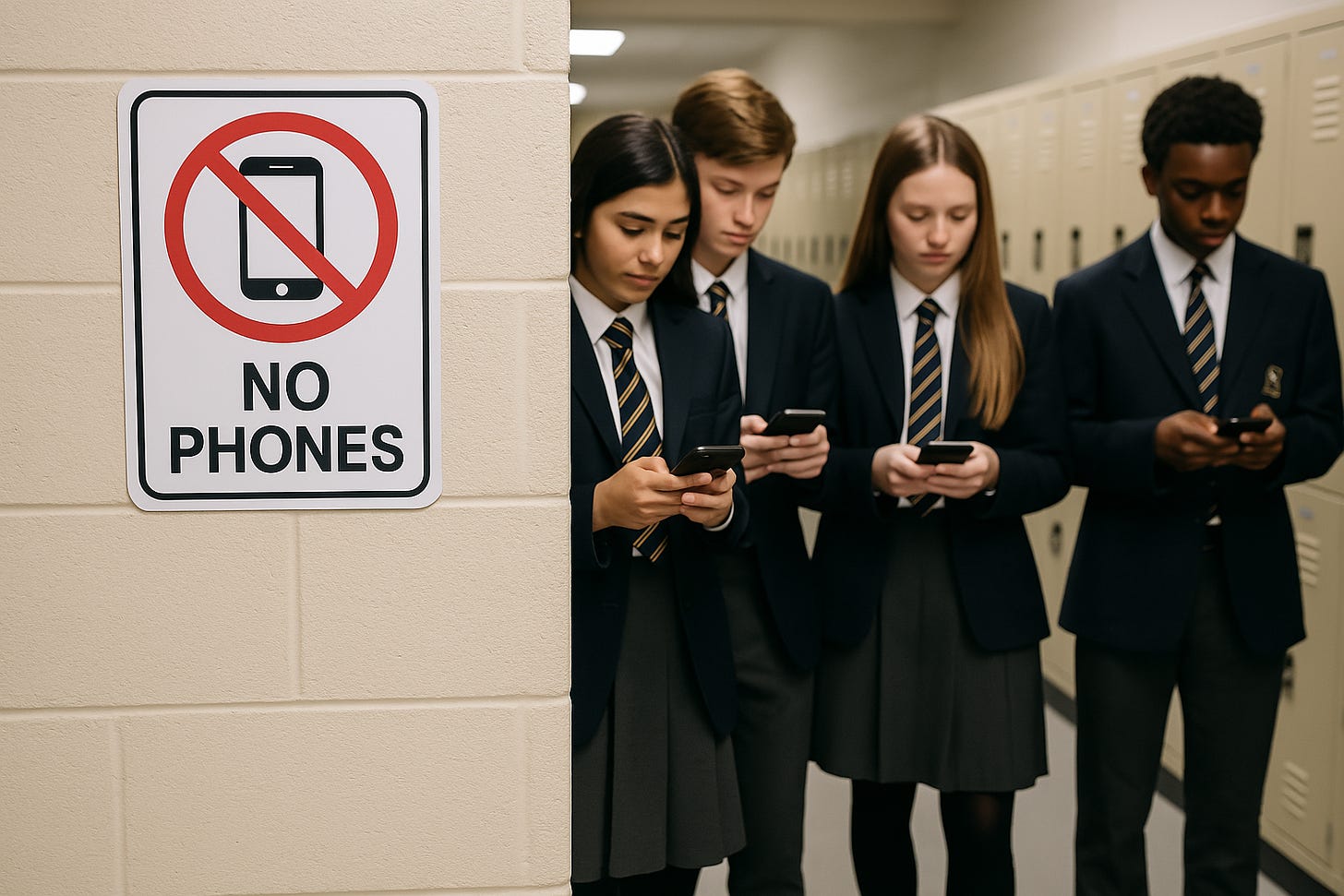We recently wrote a series of blog posts about rules which are frequently unenforced in schools.
Rules regarding mobile phones were another obvious possibility for discussion. However, unlike many of the other rules we looked at, the way schools handle phones has changed significantly during our time in teaching.
In this post, we will look at this issue in more detail, based on our experiences.
The Changing Role of Mobile Phones in Schools
As far as we can tell, most schools now take mobile phones much more seriously than they did in the past. When we started teaching in the early 00s, mobile phones were often prohibited, but only as part of a general rule against bringing valuable items into school. As phones became an essential part of everyday life, attitudes gradually softened, and schools allowed pupils to use phones at break and lunchtimes. Some schools went further and encouraged pupils to bring their own devices for educational use.1 Even schools that did not go this far sometimes let teachers permit phone use for specific tasks, such as photographing homework or looking up information. These exceptions created grey areas that made it easier for pupils to misuse phones.
The liberal approach became harder and harder to maintain as more and more phones had cameras and easy access to the internet. Misuse became common, and safeguarding risks emerged. The ‘happy slapping’ craze, where assaults were filmed on mobile phones and shared, prompted many schools to rethink their policies. As this, and other risks (discussed below), became obvious, schools again changed their rules.
Approaches varied, but the trend was towards stricter control. Phones were banned from use during the school day, and some schools insisted that phones should not be visible at all. In a school where one of us worked, pupils were allowed to keep their phones on their desks during lessons, as long as they were not used. However, simply having phones out made it much harder to enforce the rules and encouraged misuse, and the policy was tightened up. In some cases, exceptions were made for Sixth Form students who were allowed, for example, to take photographs of revision notes. However, outside of Sixth Form, any phone use, or getting a phone out, typically led to sanctions.
Challenges in Enforcing Phone Policies
While these sorts of policies are now normal, inconsistency remains an issue in some schools, particularly when dealing with the most serious incidents. We have worked in schools where the expectation is that any unauthorised phone use leads immediately to confiscation, usually by a senior member of staff. One question is whether a phone should be confiscated if it goes off in a pupil’s bag? In some schools, it’s simply impractical for teachers to enforce the rule. Getting the phone off a pupil can be difficult and is likely to lead to a very public confrontation, so some teachers ignore minor incidents rather than risk escalation.
It takes a certain level of seriousness, or rules about phones become impossible to enforce consistently. Schools need to be clear about their approach. Some schools have a policy that phones are not allowed on site under any circumstances. However, this can lead to conflict with parents who want their child to have a phone for the journey home for safety reasons.
Managing Phones on Site
If a school chooses to allow phones on site, it requires a proper system for managing them, particularly if they are to be confiscated. It is not acceptable for teachers to keep confiscated phones in their pockets or drawers, as this creates unnecessary risks. Schools need a clear and safe process for confiscating, storing and returning phones.
One solution we have seen work well involved collecting phones at the start of the school day. Pupils were expected to deposit their phones in lockers during morning registration and retrieve them at the end of the day. This removed a major potential source of conflict during lessons. If pupils did not have their phones with them, there was no need for teachers to deal with phones going off or being used inappropriately. However, this system relied on the school having enough lockers available. Not every school has the space or resources to implement such an approach.
The Safeguarding Risks of Mobile Phones
Even with stricter policies, phones remain a major safeguarding concern. Inappropriate filming, sexting, viral misbehaviour, and harassment organised through messaging apps all represent serious risks to pupils and staff alike.
Mobile phones can be used to intimidate staff. One of us has experienced a pupil phoning their parent from the classroom, immediately after being challenged about their behaviour, so that the parent could argue about this. A more common problem is pupils recording staff without permission and sharing it on social media. Schools vary widely in how seriously they take such incidents. In the worst cases, teachers can be left feeling powerless. In some cases2, viral trends on TikTok and similar platforms have caused significant problems within schools. Pupils have also used mobile phones to set up WhatsApp groups aimed at bullying or harassing staff.
The presence of phones also creates practical difficulties. Pupils who ask to leave lessons to go to the toilet may actually be leaving to use their phones to message friends. Where there are too many phones in circulation, managing pupil behaviour becomes much more difficult.
Over time, schools have learned that allowing any leeway with mobile phones can quickly undermine behaviour policies. In our experience, mobile phones can be toxic to a school environment if not properly controlled. Mobile phones are not just a classroom management issue — they represent one of the most significant safeguarding challenges facing schools today.
Sometimes referred to as “Bring Your Own Device”.
For instance, “the TikTok riots”.








